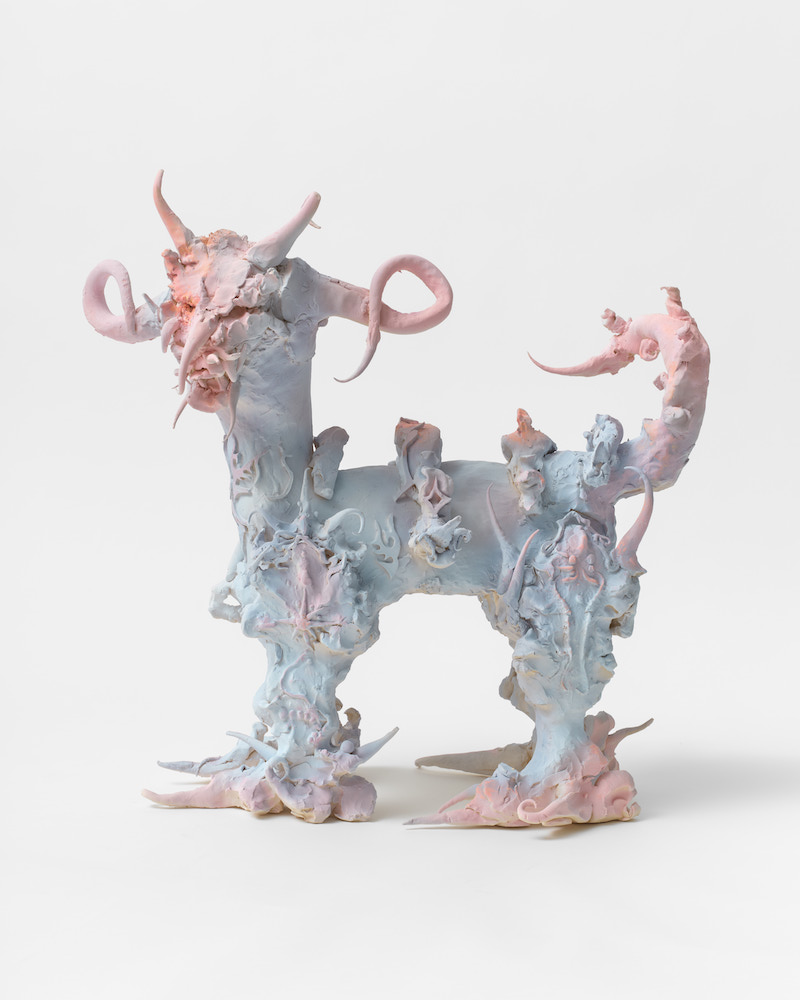Feathers, fur, gills, horns, tails (spiked and scaled), claws, talons, hooves, and forked tongues are some of the characteristics that adorn Evangeline AdaLioryn’s strange amalgamations. The locust of the exhibition, “Her Labyrinth,” presents an assemblage of creatures and ritualistic objects that coalesce in the pit of the gallery, creating a shrine-like enclosure of candy-coated divinations that seem to ferment, secrete, hatch and mutate.
The exhibition culminates in a single installation of lustrous porcelain stoneware sitting atop pedestals, imagined as supernatural artifacts, divine excavations assembled to honor and celebrate their guardianship along the artist’s quest for self. Huddled in the center of the room, a series of zoomorphic bodies and opalescent vessels face one another, animated by something subterranean giving shape to the artist’s memories, experiences, and sense of identity—an amalgamation of wreckage providing compost for resurgence, for fomenting mythologies and fictions containing past and future selves that collide and combust.

Evangeline AdaLioryn, Guardian Dog, 2023. Courtesy of Sebastian Gladstone.
An enchantment of serpentine gazes form the processionary aisles of the installation—flanked by sets of twin creatures AdaLioryn refers to as “saints” and appear to me as phosphorescent medusas or monstrous eels. Their eyeless sockets resemble transfixed gargoyles as their slippery supine necks stretch out, silently scanning and surveying the room’s flow of intruders. Along the head of the “banquet,” an arrangement of morphic figures forms an ambulatory or altar-like enclosure. Lace-like tendrils and latticed arms overflow, creating self-protective shells that resemble exquisitely embroidered capes, each epaulet and embellishment signifying an experience, a feeling solidified into a hard-obscured memory. Their delicate and ornate shells contrast with their faces, which appear vandalized, their eyes plucked from their sockets, their cheeks and mouths deformed to resemble a child’s ball of discarded playdough. One imagines the possible expressions resting beneath their obfuscated mugs—a toothy grin? Beguiling eyes? A snarling nose? One is reminded of Santa Lucia, or St. Lucy—the patron saint of light and vision—historically depicted holding a twin set of disembodied eyeballs, associated with her martyrdom and muddy mythology in which she gouges her own eyes from her sockets in an act of resistance. The hollow sockets in AdaLioryn’s cosmology recall plant stomata—tiny gaping pores that act as “mouths” to communicate via ancient channels of knowledge, emitting gaseous exchanges invisible and inaudible to mortal humans. The artist embraces sensory modes such as these as an alternative means to think about communication as a series of silent-precautional echoes, waves they refer to as “echolocations” that pervade their labyrinth of memories, leading them back to their center.
The inner forces that activate AdaLioryn’s mythology evoke certain geological phenomena, like the reformation of lapilli, a material formed by volcanic eruptions—ejected matter forced to morph from its liquid-molten state to a solid as it hurls through space, clinging to the nearest terrestrial landing, nucleating itself to the earth’s crust, forming a multi-layered shell from the volcanic ash that continues to fall. Beneath its rind-like exterior, the lapilli retains its molten core in the form of a crystal, prisms reminiscent of its former identity.
Evangeline AdaLioryn presents memory as beyond what is “seen,” paying homage to former and ever-present selves, guides that heal and hold the potential to take on infinite forms.
Sebastian Gladstone
Avangeline AdaLioryn: Her Labyrinth
5523 Santa Monica Blvd.,
Los Angeles, CA 90038
On view through April 27th, 2024


